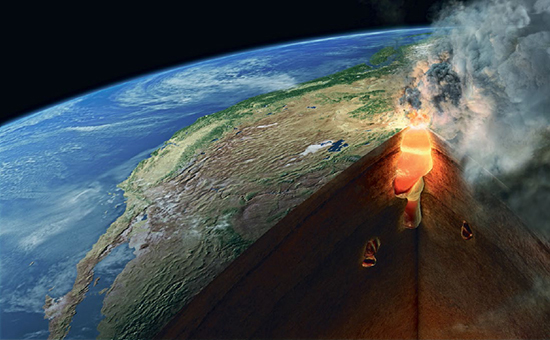~100,000
Yellowstone Supervolcano
The most powerful volcanic explosion in modern history was the 1815 eruption of Mount Tambora in Indonesia. Even though it led to the deaths of more than 100,000 people and significantly changed the Earth’s climate for several years, Tambora is still rated only a 7 out of 8 on the Volcanic Explosivity Index (VEI). To be rated an 8, the volcano has to be a monster that geologists call a supervolcano.
Supervolcano eruptions are defined as those that eject more than ~250 cubic miles (~1,000 cubic kilometers, or about one-quarter the volume of the Grand Canyon) of ash, dust, and gas onto the surface of the Earth and into its atmosphere. Plumes from supervolcanoes push these massive amounts of dust and other Sun-blocking aerosols into the stratosphere and can thus have a profound and long-lasting influence on the Earth’s climate. Because they are so intense, they are also extremely rare, with only one or two such eruptions occurring every 100,000 years. No supervolcanoes have erupted in recorded history; evidence from the geologic record shows that the last few erupted about 25,000 years ago (Taupo, New Zealand) and 74,000 years ago (Toba, Indonesia).
There are dormant supervolcanoes among us today, however. Among the most famous is the 34-by-45-mile-wide (55 by 72 kilometers) caldera that encompasses Yellowstone National Park in the US state of Wyoming. Even though it is far from an active tectonic plate margin, Yellowstone has been the site of significant geothermal activity and prehistoric volcanism for millions of years because the region overlies a mantle hotspot. Unlike the hotspot in the middle of the Pacific plate under the Hawaiian Islands, however, the Yellowstone hotspot is under a deep layer of continental crust, and its heat has to percolate through much more rock before it can be released in volcanic eruptions.
The Yellowstone supervolcano last erupted about 630,000 years ago, covering most of North America with thick ash and likely cooling the global climate for years. Luckily, there is no evidence for an imminent eruption in the near future. Still, because the consequences of such an eruption would be so extreme, the region is very carefully monitored for seismic or other evidence indicating potential future activity.
SEE ALSO Plate Tectonics (c. 4–3 Billion BCE?), The Atlantic Ocean (c. 140 Million BCE), Hawaiian Islands (c. 28 Million BCE), Pompeii (79), Huaynaputina Eruption (1600), Mount Tambora Eruption (1815), Krakatoa Eruption (1883), Exploring Katmai (1915), Mount St. Helens Eruption (1980), Volcanic Explosivity Index (1982)
Artist’s concept of cross-section of magma rising through the crust and erupting at the site of the “Yellowstone supervolcano” in central North America.
